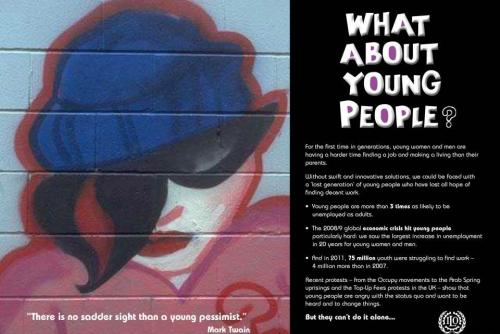Youth unemployment expected to worsen with spread of euro crisis
Jobless rates among young people will get even worse globally as the spill-over of the euro crisis spreads from advanced to emerging economies, according to a United Nations paper issued today.

“Ironically, only in developed economies are youth unemployment rates expected to fall in the coming years, but this follows the largest increase in youth unemployment among all regions since the start of the crisis,” said Ekkehard Ernst, the lead author of the UN International Labour Organization (ILO)’s paper, entitled Global Employment Outlook: Bleak Labour Market Prospects for Youth.
The paper forecasts the youth unemployment rate in developed economies dropping gradually, from 17.5 per cent this year to 15.6 per cent in 2017 – far higher than the rate of 12.5 per cent registered in 2007, before the crisis struck.
Much of this decline in the jobless rate is not due to improvements in the labour market, but rather to large numbers of young people dropping out of the labour force altogether due to discouragement, ILO noted in a news release, adding that these discouraged youth are not counted among the unemployed.
According to ILO, the world is facing a worsening youth employment crisis: young people are three times more likely to be unemployed than adults, and over 75 million youth worldwide are looking for work. The labour agency has previously warned of a “scarred” generation of young workers facing a dangerous mix of high unemployment, increased inactivity and precarious work in developed countries, as well as persistently high working poverty in the developing world.
The ILO paper notes that the global youth unemployment rate will reach 12.9 per cent by 2017 – up 0.2 percentage points from forecasts for 2012. Also, the youth unemployment is projected to be highest in North Africa and the Middle East, with a 25 per cent rate forecast over the next years.
The labour agency notes that even in countries with early signs of a jobs recovery and where new vacancies are opening up, many unemployed youth still find it difficult to land a job. For example, a construction worker whose job was lost during the housing bust might not have the skills needed in sectors that are hiring.
“This leads to discouragement and rising NEET rates (“neither in employment, education or training”) among young people,” said Mr. Ernst, who also heads ILO’s Employment Trends Unit. “Schemes using employment guarantees and an emphasis on training could help get jobseekers off the street and into useful activities, providing a safeguard against further economic stress.”
Global and Regional Figures
The projected decline in youth unemployment in the developed economies region is not expected to be enough to pull the global rate downwards.
The paper says the global youth unemployment rate will reach 12.9 per cent by 2017 – up 0.2 percentage points from forecasts for 2012.
The impact of the euro crisis is expected to expand well beyond Europe, affecting economies in East Asia and Latin America as exports to advanced economies have faltered.
In North Africa and the Middle East, youth unemployment rates are projected to remain above 25 per cent over the next years and might even rise further in parts of these regions.
Youth unemployment rates are forecast to rise from 9.5 per cent this year to 10.4 per cent in 2017 in East Asia, with little change projected in Latin America and the Caribbean and in Sub-Saharan Africa.
According to the paper, such youth guarantees can come at very limited cost, less than half a per cent of gross domestic product among European countries.
“In times of constrained public finances, this may seem like a large additional burden, but it will be less than the additional costs that come from young unemployed people permanently losing touch with the labour market,” the paper states.
At its annual conference in June this year, ILO adopted a resolution calling for immediate, targeted and renewed action to tackle the youth employment crisis. The resolution provides a portfolio of tried and tested measures in five areas: macro-economic policies, employability, labour market policies, youth entrepreneurship and rights. It underscores the need for balance, coherence and complementarity across the policy measures.
Source:UN News
- 409 reads
Human Rights
Ringing FOWPAL’s Peace Bell for the World:Nobel Peace Prize Laureates’ Visions and Actions

Protecting the World’s Cultural Diversity for a Sustainable Future

The Peace Bell Resonates at the 27th Eurasian Economic Summit

Declaration of World Day of the Power of Hope Endorsed by People in 158 Nations

Puppet Show I International Friendship Day 2020

